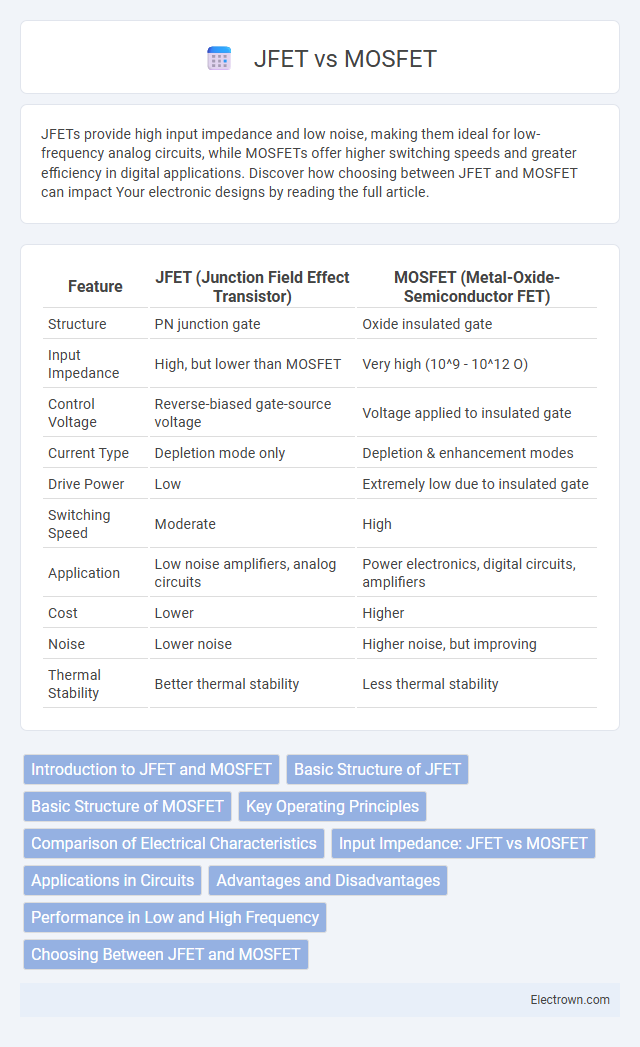JFETs provide high input impedance and low noise, making them ideal for low-frequency analog circuits, while MOSFETs offer higher switching speeds and greater efficiency in digital applications. Discover how choosing between JFET and MOSFET can impact Your electronic designs by reading the full article.
Table of Comparison
| Feature | JFET (Junction Field Effect Transistor) | MOSFET (Metal-Oxide-Semiconductor FET) |
|---|---|---|
| Structure | PN junction gate | Oxide insulated gate |
| Input Impedance | High, but lower than MOSFET | Very high (10^9 - 10^12 O) |
| Control Voltage | Reverse-biased gate-source voltage | Voltage applied to insulated gate |
| Current Type | Depletion mode only | Depletion & enhancement modes |
| Drive Power | Low | Extremely low due to insulated gate |
| Switching Speed | Moderate | High |
| Application | Low noise amplifiers, analog circuits | Power electronics, digital circuits, amplifiers |
| Cost | Lower | Higher |
| Noise | Lower noise | Higher noise, but improving |
| Thermal Stability | Better thermal stability | Less thermal stability |
Introduction to JFET and MOSFET
JFET (Junction Field Effect Transistor) and MOSFET (Metal-Oxide-Semiconductor Field Effect Transistor) are essential types of field-effect transistors widely used in electronic circuits. JFET operates by controlling current through a reverse-biased p-n junction, while MOSFET uses an insulated gate to regulate the flow of charge carriers, providing high input impedance and low power consumption. Understanding the fundamental differences in gate structure and operation helps you select the optimal transistor type for switching and amplification applications.
Basic Structure of JFET
The basic structure of a JFET (Junction Field Effect Transistor) consists of a channel of semiconductor material, typically n-type or p-type, flanked by two p-n junctions called the gate regions. The gate terminals control current flow through the channel by reverse-biasing these junctions, which modulates the width of the conductive channel without requiring gate current. This contrasts with MOSFETs that use an insulated gate oxide layer, enabling voltage-controlled conductivity with very high input impedance.
Basic Structure of MOSFET
The basic structure of a MOSFET consists of a metal gate electrode separated from the underlying semiconductor channel by a thin insulating layer of silicon dioxide (SiO2), creating a field-effect transistor. The device includes source and drain terminals on either side of the channel, with the gate voltage controlling current flow by modulating the conductivity of the channel. Unlike the JFET, which uses a pn junction to control current, the MOSFET relies on the electric field effect from the insulated gate for switching operations.
Key Operating Principles
JFETs (Junction Field-Effect Transistors) operate by controlling current through a reverse-biased pn-junction, where the depletion region modulates the channel conductivity; MOSFETs (Metal-Oxide-Semiconductor FETs) use an insulated gate to induce a conductive channel via an electric field without direct current flow through the gate. JFETs are normally-on devices (depletion-mode), while MOSFETs can be either depletion-mode or enhancement-mode, affecting how you manage switching and amplification in circuits. Understanding these key operating principles helps optimize your choice for low-noise amplification or high-speed switching applications.
Comparison of Electrical Characteristics
JFETs typically exhibit lower input capacitance and noise compared to MOSFETs, making them ideal for low-noise analog applications. MOSFETs offer higher input impedance and faster switching speeds due to their insulated gate structure, which reduces gate leakage current significantly. Your choice between the two depends on the requirements for voltage handling, switching speed, and noise performance in your circuit design.
Input Impedance: JFET vs MOSFET
JFETs typically exhibit high input impedance ranging from 10^9 to 10^12 ohms, making them suitable for low-noise and high-impedance applications, whereas MOSFETs offer even higher input impedance, often exceeding 10^12 ohms due to their insulated gate structure. The gate of a JFET is reverse-biased, limiting leakage current, but MOSFETs input gates are insulated with a thin oxide layer, minimizing gate current to almost zero and enhancing your circuit's sensitivity. Choosing between JFET and MOSFET input impedance depends on the specific requirements of signal integrity and noise tolerance in your electronic design.
Applications in Circuits
JFETs are commonly used in low-noise amplifiers and analog switches due to their high input impedance and low gate leakage current, making them ideal for sensitive signal processing. MOSFETs dominate power management applications, such as switching regulators and motor controllers, because of their fast switching speeds and high efficiency. Your choice between JFET and MOSFET depends on factors like noise sensitivity and power handling requirements in your specific circuit design.
Advantages and Disadvantages
JFETs offer low noise and high input impedance, making them ideal for low-signal applications, but they have limited input voltage range and are less versatile than MOSFETs. MOSFETs provide high switching speed, greater power efficiency, and a wider input voltage range, yet they are more susceptible to static damage and can have higher gate capacitance. The choice between JFET and MOSFET depends on application-specific requirements such as noise sensitivity, switching frequency, and power handling.
Performance in Low and High Frequency
JFETs exhibit superior noise performance and linearity at low frequencies, making them ideal for low-frequency analog signal applications. MOSFETs outperform JFETs at high frequencies due to their higher input impedance and faster switching speeds, which enhance high-frequency amplifier and RF circuit performance. The parasitic capacitances in MOSFETs, however, can limit their efficiency at extremely high frequencies compared to JFETs.
Choosing Between JFET and MOSFET
Choosing between JFET and MOSFET depends primarily on your application's voltage, current requirements, and switching speed. JFETs offer low noise and high input impedance, making them ideal for analog circuits and sensitive signal amplification. MOSFETs provide faster switching, higher input impedance, and better efficiency in digital circuits and power regulation, ensuring optimal performance in your design.
JFET vs MOSFET Infographic

 electrown.com
electrown.com